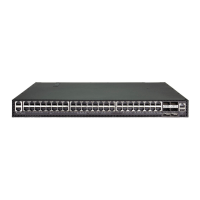C
HAPTER
34
| ERPS Commands
– 1099 –
condition. If it is an R-APS (NR, RB) message without a DNF
indication, all Ethernet Ring Nodes flush their FDB. This action
unblocks the ring port which was blocked as a result of an
operator command.
■
Recovery with non-revertive mode is handled in the following way:
a. The RPL Owner Node, upon reception of an R-APS (NR) message
and in the absence of any other higher priority request does not
perform any action.
b. Then, after the operator issues the erps clear command at the
RPL Owner Node, this ring node blocks the ring port attached to
the RPL, transmits an R-APS (NR, RB) message over both ring
ports, informing the ring that the RPL is blocked, and flushes its
FDB.
c. The acceptance of the R-APS (NR, RB) message triggers all ring
nodes to unblock any blocked non-RPL which does not have an
SF condition. If it is an R-APS (NR, RB) message without a DNF
indication, all ring nodes flush their FDB. This action unblocks
the ring port which was blocked as result of an operator
command.
EXAMPLE
Console(config-erps)#non-revertive
Console(config-erps)#
propagate-tc This command enables propagation of topology change messages for a
secondary ring to the primary ring. Use the no form to disable this feature.
SYNTAX
[no] propagate-tc
DEFAULT SETTING
Disabled
COMMAND MODE
ERPS Configuration
COMMAND USAGE
◆ When a secondary ring detects a topology change, it can pass a
message about this event to the major ring. When the major ring
receives this kind of message from a secondary ring, it can clear the
MAC addresses on its ring ports to help the secondary ring restore its
connections more quickly through protection switching.
◆ When the MAC addresses are cleared, data traffic may flood onto the
major ring. The data traffic will become stable after the MAC addresses
are learned again. The major ring will not be broken, but the bandwidth
of data traffic on the major ring may suffer for a short period of time
due to this flooding behavior.

